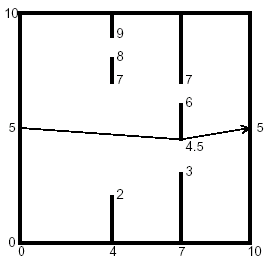「POJ1556」The Doors
Description
You are to find the length of the shortest path through a chamber containing obstructing walls. The chamber will always have sides at x = 0, x = 10, y = 0, and y = 10. The initial and final points of the path are always (0, 5) and (10, 5). There will also be from 0 to 18 vertical walls inside the chamber, each with two doorways. The figure below illustrates such a chamber and also shows the path of minimal length.


Input
The input data for the illustrated chamber would appear as follows.
2
4 2 7 8 9
7 3 4.5 6 7
The first line contains the number of interior walls. Then there is a line for each such wall, containing five real numbers. The first number is the x coordinate of the wall (0 < x < 10), and the remaining four are the y coordinates of the ends of the doorways in that wall. The x coordinates of the walls are in increasing order, and within each line the y coordinates are in increasing order. The input file will contain at least one such set of data. The end of the data comes when the number of walls is -1.
Output
The output should contain one line of output for each chamber. The line should contain the minimal path length rounded to two decimal places past the decimal point, and always showing the two decimal places past the decimal point. The line should contain no blanks.
Sample Input
|
1 2 3 4 5 6 |
1 5 4 6 7 8 2 4 2 7 8 9 7 3 4.5 6 7 -1 |
Sample Output
|
1 2 |
10.00 10.06 |
题解
此题只要将图中线段的端点拿出来连边即可,需要判断是否不于其它线段相交
然后随便做个最短路
|
1 2 3 4 5 6 7 8 9 10 11 12 13 14 15 16 17 18 19 20 21 22 23 24 25 26 27 28 29 30 31 32 33 34 35 36 37 38 39 40 41 42 43 44 45 46 47 48 49 50 51 52 53 54 55 56 57 58 59 60 61 62 63 64 65 66 67 68 69 70 71 72 73 74 75 76 77 78 79 80 81 82 83 84 85 86 87 88 89 90 91 92 93 94 95 |
#include<iostream> #include<cstdio> #include<cstring> #include<cmath> #define eps 1e-5 #define inf 1e10 using namespace std; int n,m,k,cnt,head[201],q[201]; bool inq[201]; double d[201]; struct point{double x,y;}p[101]; struct line{point a,b;}l[101]; struct edge{int to,next;double v;}e[50001]; double sqr(double x){return x*x;} double dis(point a,point b) {return sqrt(sqr(a.x-b.x)+sqr(a.y-b.y));} void ins(int u,int v,double w) {e[++cnt].to=v;e[cnt].v=w;e[cnt].next=head[u];head[u]=cnt;} void insert(int u,int v,double w) {ins(u,v,w);ins(v,u,w);} void con(double x1,double y1,double x2,double y2) { m++;l[m].a.x=x1;l[m].a.y=y1; l[m].b.x=x2;l[m].b.y=y2; } point sub(point a,point b) {point t;t.x=a.x-b.x;t.y=a.y-b.y;return t;} double cmul(point a,point b) {return a.x*b.y-a.y*b.x;} double turn(point p1,point p2,point p3) {return cmul(sub(p3,p1),sub(p2,p1));} bool cross(line a,line b) { if(turn(a.a,a.b,b.a)*turn(a.a,a.b,b.b)>=0)return 0; if(turn(b.a,b.b,a.a)*turn(b.a,b.b,a.b)>=0)return 0; return 1; } bool jud(point a,point b) { line t;t.a=a;t.b=b; for(int i=1;i<=m;i++) if(cross(l[i],t))return 0; return 1; } void build() { for(int i=1;i<=k;i++) for(int j=i+1;j<=k;j++) if(jud(p[i],p[j]))insert(i,j,dis(p[i],p[j])); } void spfa() { for(int i=1;i<=k;i++)d[i]=inf; int t=0,w=1; q[0]=1;d[1]=0;inq[1]=1; while(t!=w) { int now=q[t];t++;if(t==201)t=0; for(int i=head[now];i;i=e[i].next) { if(d[now]+e[i].v<d[e[i].to]) { d[e[i].to]=d[now]+e[i].v; if(!inq[e[i].to]) {inq[e[i].to]=1;q[w++]=e[i].to;if(w==201)w=0;} } } inq[now]=0; } } int main() { while(scanf("%d",&n)&&n!=-1) { memset(head,0,sizeof(head)); m=k=cnt=0; p[++k].x=0;p[k].y=5; for(int i=1;i<=n;i++) { double x,y1,y2,y3,y4; scanf("%lf%lf%lf%lf%lf",&x,&y1,&y2,&y3,&y4); p[++k].x=x;p[k].y=y1; p[++k].x=x;p[k].y=y2; p[++k].x=x;p[k].y=y3; p[++k].x=x;p[k].y=y4; con(x,0,x,y1);con(x,y2,x,y3);con(x,y4,x,10); } p[++k].x=10;p[k].y=5; build(); spfa(); if(d[k]==inf)printf("-1\n"); else printf("%.2lf\n",d[k]); } return 0; } |
Subscribe
